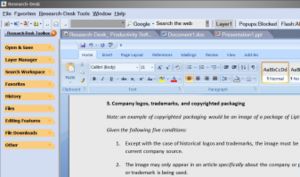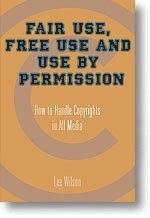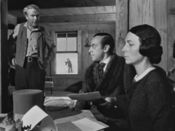Archive:Fair Use Policy, Media: Difference between revisions
imported>Stephen Ewen |
imported>Stephen Ewen |
||
| Line 209: | Line 209: | ||
===C. Exceptions=== | ===C. Exceptions=== | ||
#When the copyright holder ''explicitly denies'' by policy or private communication that use of an instance of their media is fair use.<ref>See [http://www.press.uchicago.edu/Misc/Chicago/permissions.html this instance from the University of Chicago] for an example of denial by policy.</ref> | #When the copyright holder ''explicitly denies'' by policy or private communication that use of an instance of their media is fair use.<ref>See [http://www.press.uchicago.edu/Misc/Chicago/permissions.html this instance from the University of Chicago] for an example of denial by policy. See [http://upload.wikimedia.org/wikipedia/commons/4/46/Marked-ap-letter.jpg this letter from the Associated Press] for an example of denial by private communication.</ref> | ||
#When circumstances indicate it prudent for The Media Assets Workgroup to first require the article to be nominated for approval before seeking permission. | #When circumstances indicate it prudent for The Media Assets Workgroup to first require the article to be nominated for approval before seeking permission. | ||
#Others as particular cases arise, as determined and articulated by [[CZ:Media Assets Workgroup|Citizendium's Media Assets Workgroup]]. | #Others as particular cases arise, as determined and articulated by [[CZ:Media Assets Workgroup|Citizendium's Media Assets Workgroup]]. | ||
Revision as of 02:44, 4 June 2007
The following is only a draft proposal and should not be relied upon in any way. It is conjunctive to the Citizendium Media Assets Workgroup proposal. ---Stephen Ewen 13:36, 28 May 2007 (CDT)
DISCLAIMER:
The following is not legal advice but Citizendium policy guidance. Qualifying to make a fair use claim on Citizendium does not imply that such a claim is, in fact, fair use. The onus of any such claim rests upon the uploader of such content, who is advised to make their own, independent evaluations of their fair use claims in consultation with appropriate legal counsel. For content uploaded by Citizendium contributors as fair use, the onus of their claims rest solely upon re-users of Citizendium content. Potential and actual re-users of Citizendium content are advised to make their own, independent evaluations of all Citizendium content prior re-use, in consultation with appropriate legal counsel.
- Also see Help:Images—Copyrights.
Fair use is a necessarily difficult yet navigable area of Citizendium policy. For better or for worse, it is often labor-intensive as well. Legal scholars have described the "fair use" doctrine as "a murky concept in which it is often difficult to separate the lawful from the unlawful."[1] Confounding this, there is only one sure way to tell whether the particular use you claim as "fair" really is: by having the matter resolved in federal court.[2]
Citizendium's policy on fair use is designed to steer contributors toward the "clear" side of these murky waters, to try to avoid the precarious situation of fair use challenges toward both its contributors and itself, to not prohibit fair use media altogether, and to make determinations over fair use as straightforward as possible. Citizendium's "fair use" policy largely follows that of reputable scholarly journals, while balancing and incorporating Citizendium's ideals of providing so-called "free" (libre) content to re-users.
Usage of "fair use" media on Citizendium is governed by the five tests that follow. When passed, they lead to the requirement of writing a strong and detailed fair use rationale on the media's upload page.
Readers are advised that the footnoted material throughout this page is important.
TEST ONE: Can a "free" substitute be found or created?
The most straightforward way to avoid troubles over fair use is to avoid invoking the doctrine at all. To this end you should apply TEST ONE before even considering whether to make a fair use claim.
TEST ONE: Have you given a reasonably sustained effort to obtain a substantially equivalent "free" substitute, or could such be created within a reasonable time frame?
- If YES, then go on to TEST TWO.
- If NO, then skip to TEST FOUR.
NOTE: A new good-faith attempt to locate "free" replacements of non-"free" images in articles should occur during the period between all approval and re-approval nominations and actual approval.
TEST TWO: Has the article been nominated for approval or does it have a controversial rating of Nil or Low?
As an important bolster for fair use claims, all articles in which fair use images appear must strictly adhere to Citizendium's Neutrality Policy. Fair use images should not appear in articles until any neutrality issues are settled. It is assumed that articles nominated for approval by an editor will be free from any serious neutrality issues. Editors are unlikely to give their approval to articles with evident neutrality issues, and are specifically instructed not to. At the same time, certain types of articles are inherently less controversial than others.
Thus,
TEST TWO: Has the article been nominated for approval or or does it have a controversial rating of Nil or Low?
- If YES, then go on to TEST THREE.
- If NO, then skip to TEST FOUR.
NOTE: To facilitate rapid placement of all "fair use" images after approval nomination, it is suggested that the image sources be collected in a section on an article's talk page.
TEST THREE: Does your fair use claim clearly fit into one of the categories below?
Category One: Coats of Arms, flag emblems, seals, etc., of administrative entities, political authorities and institutions

© Image courtesy of The Council of the Baltic Sea States.
Given the following five conditions:
- The image should be obtained from the official source, or be otherwise identical to that found at the official source while not being subject to another's restrictions.[3]
- In articles specifically about the entity, a disclaimer must be placed at the top of the top of the article stating, This is not an official page of [http://www.entitydomain.com|Entity name].[4]
- The image must be of the highest available quality yet only in size and resolution sufficient for adequate displaying of information.
- The image must appear in a box with text stating it is "The official [flag, seal, etc.] of [entity]."
- The image may only appear in an article:
- a. Specifically about the entity.
- b. About or discussing the type of entity or category of item in some way.
Does your fair use claim clearly fall into Category One?
- If YES, your upload DOES qualify for a fair use claim on Citizendium. Go now to Making a strong fair use claim.
- If NO, then keep reading or skip to TEST FOUR.
Category Two: Currency, stamps, vehicle license tags, and closely similar

© Image courtesy of Bank of Latvia.
Given the following two conditions:
- The image must be obtained from its official issuing source.
- It must appear in an article in some way about that which the image depicts.
Does your fair use claim clearly fall into Category Two?
- If YES, your upload DOES qualify for a fair use claim on Citizendium. Go now to Making a strong fair use claim.
- If NO, then keep reading or skip to TEST FOUR.
Category Three: Company logos, trademarks, copyrighted packaging, and closely similar

© Image courtesy of The Coca-Cola Company.
Given the following six conditions:
- The logo or trademark must be obtained from its official source, or be otherwise identical to that found at the official source while not being subject to another's restrictions.
- Images of copyrighted packaging[5] must be from the official source, self-made, or in no way subject to another's copyright
- A disclaimer must be placed at the top of the top of the article stating, This is not an official page of [http://www.companydomain.com|Company name (and product, if applicable)].[6]
- The image must be good quality, i.e., not blurry and preferably in PNG format, yet only in size and resolution sufficient for adequate displaying of information
- The image must appear in a box with text stating, "The official [logo, trademark, packaging] of [company or product]," e.g., "The official Coca-Cola trademark of the Coca-Cola Company."
- The image may only appear in an article:
- a. Specifically about the company or product whose logo, trademark, or copyrighted packaging is being used.
- b. About or discussing logos and/or trademarks and/or or copyrighted packaging in some way, in which case the examples chosen must be discussed specifically and must be of an iconic nature.
Does your fair use claim clearly fall into Category Three?
- If YES, your upload DOES qualify for a fair use claim on Citizendium. Go now to Making a strong fair use claim.
- If NO, then keep reading or skip to TEST FOUR.
Category Four: Software screen captures

© Image courtesy of Winferno Software.
Given the following five conditions:
- The software screen capture must illustrate a specific point within the article.
- Partial screen captures of software must be used whenever possible.
- The software screen capture must be as small as possible to convey the information. See and click on the example to the right.
- If full screen, the image must be no more than about 10% of the original pixel size as might be displayed on a typical 15 inch (38 cm) computer screen.
- The image should be self-made, or in no way subject to another's copyright.
Does your fair use claim clearly fall into Category Four?
- If YES, your upload DOES qualify for a fair use claim on Citizendium. Go now to Making a strong fair use claim.
- If NO, then keep reading or skip to TEST FOUR.
Category Five: Book, periodical, and disc covers, and promotional posters, comic strip frames, and closely similar

© Image courtesy of Allworth Press.
Given the following two conditions:
- The image as uploaded is about the same size and resolution as the example book cover shown to the right, or whatever is in size and resolution small enough to still display adequate information.
- The image must be obtained from its official source, whenever available.[7]
- The image may only appear in an article about the following:
- a. The book, periodical or periodical edition, disc, poster event, or comic itself.
- b. The author, artist, or publisher, in which case a section of the article must be about the book, periodical or periodical edition, album, disc, poster event, or comic itself.
- c. The person, group, or historical event that appears on the cover of the periodical, in which the periodical's coverage of the person, group, or historical event must be a specific subject of discussion.
- d. A subject of which the periodical, disc, poster event, or comic strip frame[8] is a subject, in which case the image thereof must be specifically discussed in the article.
NOTE: Pictorial depictions of a person or group on any such cover may not be used under fair use as the lead image for an article about the person or group.
Does your fair use claim clearly fall into Category Five?
- If YES, your upload DOES qualify for a fair use claim on Citizendium. Go now to Making a strong fair use claim.
- If NO, then keep reading or skip to TEST FOUR.
Category Six: Audio and video clips, including video screen captures

© Image courtesy of RKO Pictures and Turner Classic Films.
Given the following five conditions:
- The clip or screen capture must illustrate a specific point within the article.
- Audio clips should be as small as possible in both length and resolution to convey information. In no case should more than about 10% of a musical composition or speech be used and it should not encompass "the heart" of the recording.[9]
- Video screen captures should be used instead of clips, whenever possible. Clips should be no longer than about 3 seconds, or whatever is the absolute minimum required to make the specific point.
- The clip or image should be obtained from official sources whenever available, or should be self-made or otherwise in no way subject to another's copyright.
- No encryption mechanism may have been subverted to make the audio or video clip.
NOTE: Video screen captures may not be used under fair use as the lead image for an article.
Does your fair use claim clearly fall into Category Six?
- If YES, your upload DOES qualify for a fair use claim on Citizendium. Go now to Making a strong fair use claim.
- If NO, then keep reading or skip to TEST FOUR.
Category Seven: Promotional photos of famous persons, places, or things
Given the following three conditions:
- The photo must come from the official source of the person, place, or thing.
- The photos must appear in an article or article section about promotional photos.
- The photos chosen must illustrate a specific point in the article.
NOTE: Promotional photos of famous persons, places, or things may not be used under fair use as the lead image for an article about such persons or places or things.
Does your fair use claim clearly fall into Category Seven?
- If YES, your upload DOES qualify for a fair use claim on Citizendium. Go now to Making a strong fair use claim.
- If NO, then keep reading or skip to TEST FOUR.
NOTE: Category Eight may override Category Seven.
Category Eight: When the copyright holder explicitly encourages the fair use of their media
Given the following four conditions:
- The media must come from the official source.
- The explicit encouragement for fair use[10] must be documented and linked to on the media upload page.
- All other documentation requests of the copyright holder must be met.[11]
- The media must illustrate a specific point in the article and be as small as possible to adequately convey the information.
Does your fair use claim clearly fall into Category Eight?
- If YES, your upload DOES qualify for a fair use claim on Citizendium. Go now to Is it really fair use?.
- If NO, then keep reading or skip to TEST FOUR.
TEST FOUR: Can you prove permissions diligence/frustration or are there exceptions?
It is believed that most fair use claims outside of the above eight categories of TEST THREE can be avoided by diligent seeking of permission. However, there are two instances where this may not be the case.
A. The missing copyright holder
In cases where you have diligently but fruitlessly attempted to locate the copyright holder, and you can prove such attempts (by documenting them on a /Permission subpage of the image's talk page), authorities are unanimous that your fair use claim is greatly bolstered and that you'd typically avoid paying anything beyond a normal usage fee should the copyright-holder later show up and take you to court. To this end you should apply the Permissions Diligence Test, TEST FOUR, before even considering whether to make a fair use claim beyond those provided for in TEST THREE.
TEST FOUR "A": Have you diligently but unsuccessfully attempted to contact the copyright owner to ask permission, and are you prepared to document those attempts on a subpage of the image's talk page?
- If NO, your upload DOES NOT qualify for a fair use claim on Citizendium.
- If YES, then go on to TEST FIVE.
- For an example of a thus far unsuccessful permission attempt see Talk:Tux/lin64.
- For an example of a thus far probably successful but as yet inconclusive attempt see Talk:Tux/ccpenguin.jpg.
- For examples of successful attempts see Image talk:Wessel 1954 fig1.png/Permission and Image talk:Gilad Atzmon - for Citizendium.jpg/Permission.
NOTE: The volunteers of Citizendium's Media Assets Workgroup are available to serve you in obtaining images, and permissions therefor as needed.
B. Fee barriers
It is anticipated that most copyright holders will grant permission to Citizendium contributors without fee. This will certainly not always be the case, however. In some cases, fees may be simply unrealistic for a free encyclopedia project, or you may not wish to pay a fee regardless. If this is the case, you should request assistance from Citizendium's Media Assets Workgroup before even considering whether to make a fair use claim beyond those provided for in TEST THREE. The Media Assets Workgroup may be able to negotiate with the copyright holder with more leverage.
TEST FOUR "B": In the case of fees you are unwilling to pay, has Citizendium's Media Assets Workgroup unfruitfully concluded your request for assistance?
- If NO, your upload DOES NOT qualify for a fair use claim on Citizendium.
- If YES, then go on to TEST FIVE.
C. Exceptions
- When the copyright holder explicitly denies by policy or private communication that use of an instance of their media is fair use.[12]
- When circumstances indicate it prudent for The Media Assets Workgroup to first require the article to be nominated for approval before seeking permission.
- Others as particular cases arise, as determined and articulated by Citizendium's Media Assets Workgroup.
TEST FOUR "C": Do any of the above exceptions apply?
- If YES, your upload DOES NOT qualify for a fair use claim on Citizendium.
- If NO, then go on to TEST FIVE.
TEST FIVE: Is it really fair use?
The law of fair use, having been developed by courts since the 1800s, has since been codified in the United States Copyright Act, 17 USC § 107:
§ 107. Limitations on exclusive rights: Fair use
- Notwithstanding the provisions of sections 106 and 106A, the fair use of a copyrighted work, including such use by reproduction in copies or phonorecords or by any other means specified by that section, for purposes such as criticism, comment, news reporting, teaching (including multiple copies for classroom use), scholarship, or research, is not an infringement of copyright. In determining whether the use made of a work in any particular case is a fair use the factors to be considered shall include—
- the purpose and character of the use, including whether such use is of a commercial nature or is for nonprofit educational purposes;
- the nature of the copyrighted work;
- the amount and substantiality of the portion used in relation to the copyrighted work as a whole; and
- the effect of the use upon the potential market for or value of the copyrighted work.
- The fact that a work is unpublished shall not itself bar a finding of fair use if such finding is made upon consideration of all the above factors.
Thus, TEST FIVE is:
TEST FIVE: If after carefully reviewing the above fair use criteria, are you convinced your claim of fair use is fair use indeed, and are you prepared to bear complete responsibility with the copyright holder if you are wrong?
- If NO, then your upload DOES NOT qualify for a fair use claim on Citizendium.
- If YES, then proceed to Making a strong fair use claim.
Making a strong fair use claim
If you have been instructed that you may make a fair use claim in a Citizendium article, you should carefully review the section above, Is it really fair use?. Then, if you are convinced your use of the media is fair use indeed, your should document in detail your reasons for believing in your claim, answering the following questions on the media upload page:
Justifying "fair use" means making your case concerning:
- the purpose and character of the use, including whether such use is of a commercial nature or is for nonprofit educational purposes;
- the nature of the copyrighted work;
- the amount and substantiality of the portion used in relation to the copyrighted work as a whole; and
- the effect of the use upon the potential market for or value of the copyrighted work.
Additionally:
- The media upload page should include:
- A neutral, detailed description of the image, including detail about what the image depicts, that the copyright holder could not possibly find offensive.
- A link to the official source page of the image (don't link directly to the image location on the server).
- A link to the copyright holder.
- Use ©, ®, and ™ wherever appropriate.
- Editors should use {{}} in the form
{{Fairuse-editor
|copyright holder URL=
|copyright holder name=
|editor name=
|workgroup name=
|article name=
|source country=
}}
which produces
- Authors should use {{}} in the form
{{Fairuse-author
|copyright holder URL=
|copyright holder name=
|author name=
|workgroup name=
|article name=
|source country=
}}
which produces
- The the image box at the article in which the fair use image appears should include:
- Image courtesy of [Name of copyright holder].
- Use ©, ®, and ™ wherever appropriate.
See the example images above for models.
FAQ—Frequently Asked Questions
The unresponsive copyright holder
I have asked the copyright holder several times for permission but have not gotten a response.
- You should first check whether you have submitted your request in the form and substance requested by the copyright holder.[13] They will typically ignore requests otherwise. If everything seems in place in that regard, you should place an assistance request with the Media Assets Workgroup, whose request may carry more leverage. Although asking permission does not mean you must ask it, and although it does not preclude a possible fair use rational and defense in face of an unresponsive copyright holder who later challenges your use as infringement, you should consider that a judge would likely interpret silence of a located copyright holder as implicit rejection of your request.
Unique, copyrighted historical photos
What about unique historical photographs?
- Consider the Pulitzer Prize-wining Vietnam War photo by Nick Ut of the Associated Press (AP), depicting Kim Phuc Phan Thi running down the road burned and naked after a napalm bomb was dropped on her village (see the image). The AP specifically disagreed that Wikipedia's use of that photo, lest any of the AP's copyrighted photos, would constitute fair use (see the letter). Citizendium's Media Assets Workgroup hopes to seek and obtain block permission to use photo archives, such as those by the Associated Press, but it first needs a larger base of solid approved articles to prove a better reputation for Citizendium. Until such a time, to help facilitate it, and to avoid any troubles, seek permission on a photo-by-photo basis.
References and footnotes
- ↑ "Disagreements Over Fair Use: When Are You Likely to Get Sued?" http://fairuse.stanford.edu/Copyright_and_Fair_Use_Overview/chapter9/9-d.html
- ↑ Measuring Fair Use: The Four Factors http://fairuse.stanford.edu/Copyright_and_Fair_Use_Overview/chapter9/9-b.html
- ↑ For example, some collections-holders claim restriction rights over their digitized images of historical coats of arms. However, for a great source of high quality images in this category usable in Citizendium, apart from the need to make a fair use claim, see Vector-Images.com and their terms of use.
- ↑ For such entities without a web presence, simply place the name.
- ↑ An example of copyrighted packaging would be a package of Lipton Tea.
- ↑ For companies and products without a web presence, simply place the company and product name.
- ↑ For example, if you wish to use a book cover, you must first try to obtain it from its publisher's website, in which case the publisher will receive a link to both itself and its book description page on the image upload page. Book cover images from sources such as amazon.com may only be used if the publisher does not display the book cover at its own website. If this is the case, you must say so on the image upload page, and still include a link to the book's publisher as well as to the source from where you obtained the image.
- ↑ Single-frame comics (such as The Far Side or political comics) and entire strips do not fall under this category. Seek permission instead.
- ↑ Examples: 1) In an article about a CD release that has 10 songs, you may include an approximately 10 second clip of one song, but not the 10 second clip that may be the main draw toward people purchasing the CD.
- ↑ See http://memory.loc.gov/ammem/ndlpcoop/ichihtml/copyres.html for an example.
- ↑ For example, one might state, "Please cite the Reproduction Number for the item provided in the descriptive record".
- ↑ See this instance from the University of Chicago for an example of denial by policy. See this letter from the Associated Press for an example of denial by private communication.
- ↑ See The University of Chicago Press Permission Request Form for an example of the form and substance requested by a copyright holder.
Additional reading
- Copyrights and Wrongs: A basic, easy to understand guide to copyrights—by Mary E. Carter. If you are new to all these issues, this is a great, quick primer.
- Fair Use, Free Use, and Use by Permission: How to Handle Copyrights in All Media—by Lee Wilson. An excellent one volume handling of intellectual property by an intellectual property lawyer.
- Digital History: A Guide to Gathering, Preserving, and Presenting the Past on the Web—by the Center for History and New Media, George Mason University.
Tools
- Fair Use Checklist - developed by Kenneth Crews at the Copyright Management Center of Indiana University.